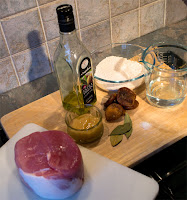Today is one of those lucky days when meat is on the menu - perhaps we got lucky at the gladiatorial games and won a few coins, or maybe our patron was feeling very generous with his gifts, or it might just be that we walked out of the front door of the farm and saw Porky the Pig standing there looking awfully delicious. Poor Porky - now you're chopped up and waiting to be cooked.
Today's recipe comes from Apicius, 7.9.1, or recipe number 287 if you want to go by that instead. I was inspired by Grainger's take on this (Grainger, S., Cooking Apicius, (Totnes, 2006) pp.62-63), and found some of her methods very useful, but I've changed a few of the ingredients. The recipe in Apicius reads roughly as follows:
Braise the ham with a generous helping of figs and three laurel leaves. Peel off the skin, chop it into squares, and cover it all with lots of honey. After, make a dough with flour and oil and wrap the ham up inside. Bake slowly and serve as soon as it's ready.- Apicius, 7.9.1
There are the usual issues with 'what type of ham should we use?', 'how many figs are needed?', and 'how much dough do we make?', but I'm starting to like the Romans' way of going by feel and using my instincts. I found that the following worked well:
Baked Honey Ham in Pastry with a Fig Sauce
Ingredients
The Meat
- 750g Lump of Unsmoked Gammon
- 8 Dried Figs
- 3 Bay Leaves
- 125g Set Honey
The Pastry
- 250g Spelt Flour
- 100ml Water
- A Pinch of Salt
- A Splash of Extra Virgin Olive Oil
Method
- Briefly sear the meat in a hot frying pan before adding to a saucepan. Add cold water, the three bay leaves, and all of the figs. Bring to the boil, then reduce to a simmer. This meat needs 20 minutes, with an extra 20 minutes per 500g. However, I gave mine just 40 minutes in total and it came out perfect. Remove from the meat from the sauce and leave it to cool.
- Whilst this is happening we need to make the pastry dough. Prepare a work surface (I used the kitchen bench) by giving it a clean and sprinkling it with flour. Take out a rolling pin and dust it with flour too.
- Mix the flour, salt, oil, and water and knead it until smooth. Take half of the dough and keep it covered with a moist towel to stop it from drying out. Place the other half onto the work surface and get ready to roll.
- This dough has to be VERY thin. The best way to do this is to roll it at the edges with a rapid backwards and forwards movement. Once you have a roughly rectangular batch of dough, place it on a floured surface and repeat with the second batch.
- By this stage the meat should be quite cool - this is important because we're adding honey to it, and it will melt otherwise. Remove the skin and chop it into little pieces. Score the meat with a knife on all sides, creating grooves for the honey to seep into. Now, grab a handful of honey and rub it all over the meat.
- With the meat honeyed up, lay one sheet of dough out on a baking tray and brush the top side with olive oil. Place the meat at one end and roll it all up!
- Brush the outside with olive oil now and wrap the whole bundle with the second bit of dough. Oil the outside of this so that it goes nice and crispy in the oven. Place back on the oiled baking tray and into an oven preheated at 180°C. Cook for 1 hour, adjusting the heat if necessary.
- For the final 15 minutes, strain the concoction you cooked the ham in through a sieve and add half of it to a pan to reduce. Using a pan with more surface area means it will reduce more quickly.
- Remove the ham from the oven, let it sit for 5 minutes, then chop it up and put it onto a plate. Pour some of the fig sauce over. Delicious.
Results
What a dish! I served this with some cabbage boiled very briefly in the remaining fig/bay/ham cooking liquid, and it went down a treat. The outside layer of pastry was crisp, the inside layer was soaked in honey and ham juices, and the ham itself was very succulent. The diners, who had no idea as to what I was making, picked up on the honey and fig flavours. What struck me most about this dish was how 'normal' it felt - this could easily have been featured in a Jamie Oliver cookbook, or served up in a local restaurant. The Romans, with this recipe, have created a truly timeless dish.





Wow!! I'm a (contemporary) Roman and can say it looks great :-) Will definitely follow this blog.
ReplyDeleteIf you need some inspiration from present times, visit Maditalianfoodies.blogspot.com :-)
Thanks! I LOVE Italian food - it was my introduction to cooking. I'll definitely keep and eye on your blog.
Delete